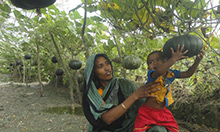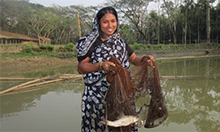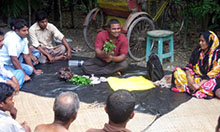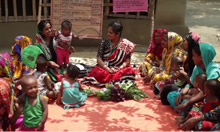Key Elements for Implementation Based on the SPRING Experience in Bangladesh
What Are Farmer Nutrition Schools?
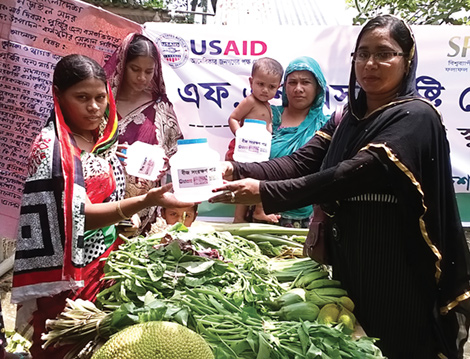
Farmer nutrition schools (FNS) improve food security, empower women, and create social and behavior change for better nutrition by—
- equipping community members with the practical knowledge and skills needed to produce nutrient-dense fruits, vegetables, and animal source foods at the household level
- promoting improved hygiene practices.
FNS are—
- low-cost
- sustainable
- scalable.
In early 2012, the U.S. Agency for International Development asked SPRING to develop an approach for improving nutrition and food security that could be quickly scaled up across its Feed the Future zone of influence along the coastal belt of Bangladesh. We built our approach on three well-established, widely respected, and evidence-based strategies:
As of 2016, there are 6,421 SPRING-implemented farmer nutrition schools across 40 upazilas in Barisal and Khulna divisions that have trained more than 126,000 pregnant and lactating women since May 2012. Analyzing results from the 2014 and 2015 rounds of a study on the effects of the FNS, we found that women who participated in a SPRING FNS had a mean dietary diversity score increase from 3.9 to 6.0, meaning that the women’s diet was nearly twice as diverse as it was when they started the FNS. Further, the consumption of animal source foods went up dramatically, with egg consumption, for example, jumping from 28 percent to 62 percent in just nine months. Dietary inadequacy dropped from 72 percent to only 16 percent over this same period. These results surfaced among other positive changes, including increased knowledge of child feeding practices and handwashing practices.1
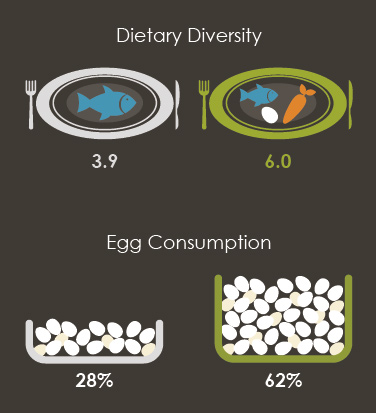
- the essential nutrition actions and essential hygiene actions (ENA/EHA)
- homestead food production (HFP)
- farmer field schools (FFS).
We called this hybrid approach "Farmer nutrition schools."
How Do Farmer Nutrition Schools Reduce Malnutrition?
Farmer nutrition schools conduct practical training sessions over nine months within small rural communities, teaching lessons on topics such as—
- the significance of nutrition and hygiene practices in households
- how to improve vegetable farming
- how to raise local chickens and cultivate fish.
An FNS participant learns techniques for—
- better food production
- improving ENA/EHA practices
- linking food production with improved nutrition and hygiene practices.
Training methods include—
- hands-on participatory sessions on improved techniques for better food production
- participatory discussions and practicing improved techniques immediately after the sessions
- observations on production, analyzing the results, and making decisions about improved techniques.
The "learning by doing" format fosters decision-making skills, strengthens community investment in nutrition, and encourages greater involvement in the program.
What Elements Are Necessary for a Successful Farmer Nutrition School Program?
SPRING/Bangladesh focuses on the promotion and support of ENA/EHA into each session of our food production training modules, which include vegetable gardening, poultry rearing, and fish production. By incorporating messages based on small "doable" actions, we ensure that FNS participants receive adequate knowledge to link their food production with improved nutrition and hygiene practices, while also promoting their ability to consume a diversified diet.
The agriculture-nutrition pathways are an important conceptual framework when designing and planning interventions that include both nutrition-sensitive and nutrition-specific activities. Our FNS work integrates both types of interventions and the agriculture-nutrition pathways serve as an important roadmap in tracking the input activities to the outputs and ultimate outcomes of the FNS work. They show, for example, how food production influences nutrition outcomes, how agricultural income can affect diet, and how women’s empowerment affects caring practices.
The FNS Approach: 11 Key Elements
| Key Element | Definition | |
|---|---|---|
| 1. | Learning by doing – practical sessions and practice immediately after the sessions | Focus on skills building – more dynamic learning style |
| 2. | Minimal inputs | Focus on skills building instead of incentives |
| 3. | No cost/Low cost solutions | Simple approaches that are sustainable |
| 4. | Year-round production of diversified foods, including animal source food | Food and nutrition security |
| 5. | Consistent and repeated messaging | Reinforcement of ideas for behavior change |
| 6. | Simple, evidence-based innovations | Simple, sustainable approaches |
| 7. | Whole family approach | Responsibility of all, greater buy-in, better chance for success |
| 8. | Proper enrollment and orientation for participants | Communities are properly sensitized to SPRING’s approach before activities begin. |
| 9. | Clear guidelines and fixed curriculum | Well-trained staff for consistent and clear messaging |
| 10. | Regular, comprehensive, and season-based lessons | Make lessons relevant, useful, and routine to ensure greatest possible impact |
| 11. | Trained cadre of staff to train and provide follow-up support | Important for scale-up of project |
What Resources and Tools Are Available?
From 2012-2017, SPRING/Bangladesh has continually improved and refined the FNS model. We also piloted, tested, refined, and published the FNS curriculum.
FNS Resources
To download or view these documents, please go here.
- Farmer Nutrition School Technical Guide - Vegetable Gardening, Native Chicken Rearing, and Pond Fish Culture
- Farmer Nutrition School Session Guide - Essential Nutrition Actions, Essential Hygiene Actions, and Homestead Food Production
- Farmer Nutrition School flashcards
- Monitoring and evaluation tools and household register book
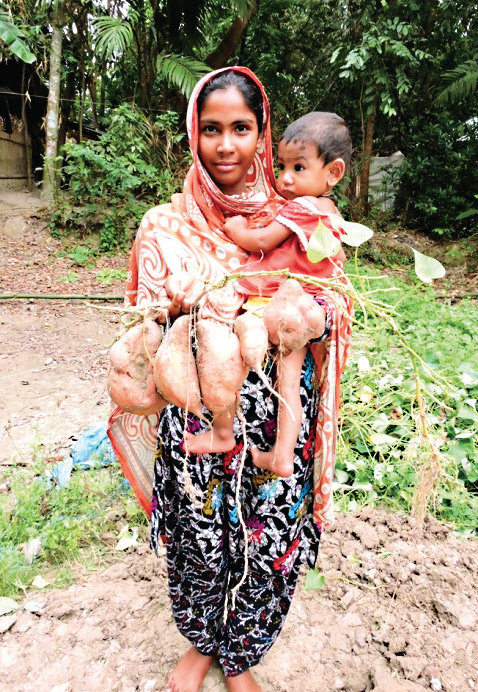
About SPRING/Bangladesh
The goal of SPRING/Bangladesh is to improve the nutritional status of pregnant and lactating women (PLW) and children under the age of two years in Barisal and Khulna divisions by promoting and supporting the adoption of ENA/EHA and the consumption of nutritious and diverse diets through a multichannel and integrated approach, providing wider coverage and reinforcing nutrition-specific and nutrition-sensitive messages.
Our work targets the 1,000-day window of opportunity among PLW and children under two years of age, using a social and behavior change strategy within the health and agriculture sectors to reduce and prevent stunting in young children. SPRING/Bangladesh is working in 40 upazilas, or sub-districts, in the USAID Feed the Future zones of influence of Barisal and Khulna divisions. In addition to its FNS work, SPRING works with health and agricultural workers within the Government of Bangladesh and other NGOs to develop the confidence and capacity to counsel households with pregnant and lactating women and children under two on nutrition and hygiene at a variety of contact points, from community clinics to home visits.
Footnotes
1 SPRING. Forthcoming. Cohort Study: Sustainability of Improved Practices Following Graduation from the SPRING Farmer Nutrition Schools in Bangladesh. Arlington, VA: Strengthening Results, Partnerships, and Innovations in Nutrition Globally (SPRING) project.
